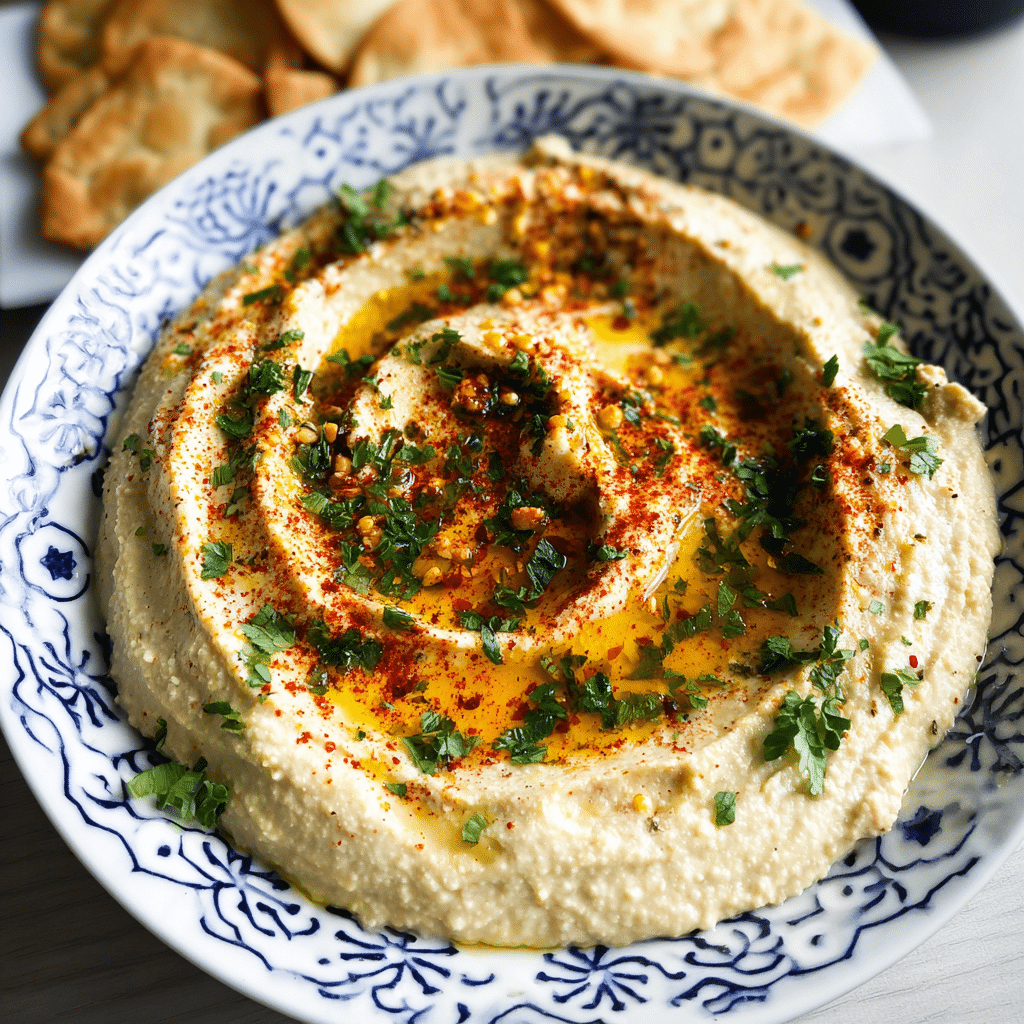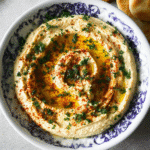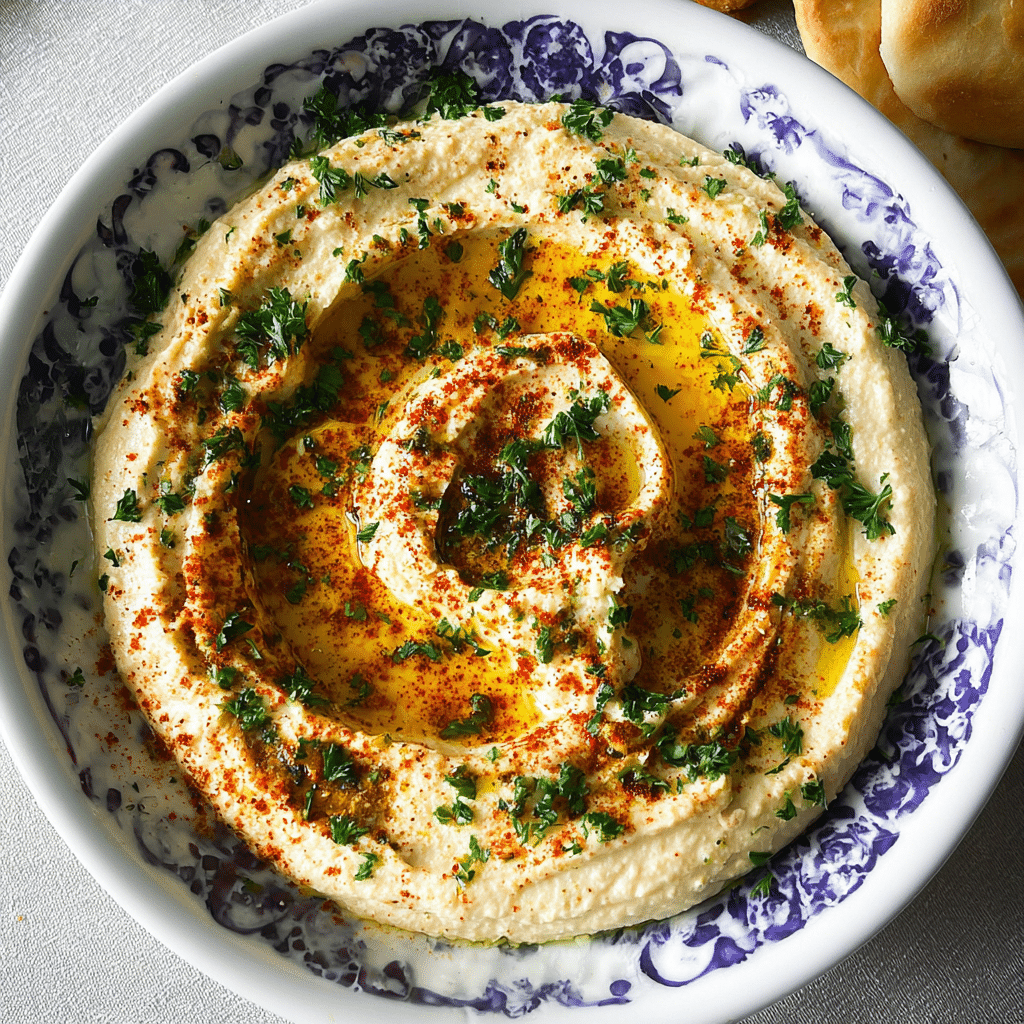Hummus Mediterranean Recipe starts with a memory that changed everything for me. Picture this: I’m standing in a bustling street market in Jerusalem, watching a vendor transform humble chickpeas into liquid gold. The aroma of toasted sesame and fresh lemon filled the air, and when I tasted that first spoonful creamy, nutty, with just the right tang I knew I’d never settle for store-bought hummus again.
I’m Emeli, and at FoodFansy, I believe the best recipes are the ones that connect us to places, people, and stories. This Hummus Mediterranean Recipe is my love letter to the Middle East, refined through countless batches in my home kitchen. After years of testing (and yes, some grainy failures), I’ve cracked the code to restaurant-quality hummus that comes together in just 10 minutes.
In this guide, you’ll discover the secret to silky-smooth texture, learn why tahini-first blending matters, and get my pro tips for avoiding the biggest hummus mistakes. Whether you’re prepping for a mezze platter or just need a healthy snack, this recipe delivers every single time.
Why This Hummus Mediterranean Recipe Works
This isn’t just another chickpea dip it’s a formula for perfection that honors traditional methods while fitting into modern life. Here’s why home cooks keep coming back to this Hummus Mediterranean Recipe:
- Uses simple, pantry-friendly ingredients you probably already have on hand
- Ready in 10 minutes with a food processor no soaking or cooking required when using canned chickpeas
- Infinitely customizable for spicy, herby, or roasted variations
- Healthier and cheaper than store-bought versions packed with preservatives
- Perfect for meal prep stays fresh for up to a week and tastes better each day
The magic lies in the technique: blending tahini and lemon juice first creates an emulsion that makes everything impossibly creamy. It’s the difference between grainy dip and silky perfection.
Choosing the Right Chickpeas for Your Hummus Mediterranean Recipe
The foundation of transcendent hummus starts with your chickpea choice. This decision impacts texture, flavor, and how much effort you’ll invest.
Best Chickpea Options for This Recipe
Canned chickpeas are my weeknight hero. They’re pre-cooked, consistent, and deliver excellent results with minimal fuss. Look for brands with firm, plump chickpeas and minimal salt. The trade-off? Slightly less control over texture compared to dried.
Dried chickpeas are the traditional choice when you want maximum creaminess. Soaking overnight and cooking with a pinch of baking soda breaks down the skins, creating that melt-in-your-mouth texture you’d find in a Tel Aviv café. The effort pays dividends if you’re making large batches or seeking absolute perfection.
Buying Tips
Inspect canned chickpeas through the can or jar if possible you want whole, unbroken legumes. Check the sodium content; lower is better since you’ll control seasoning. For dried chickpeas, choose ones that are uniform in size and free of shriveled or discolored beans.
Your ethnic markets often carry superior dried chickpeas at better prices than mainstream grocery stores. I always grab a few bags when I find high-quality ones.
Substitutions
In a pinch, you can use white beans (cannellini or great northern) for a milder, slightly sweeter dip. The texture will be softer and the flavor less nutty, but it’s delicious in its own right. Some cooks also love combining half chickpeas with half cooked cauliflower for a lighter, veggie-forward version.
Ingredients & Prep for Your Hummus Mediterranean Recipe
Great hummus lives in the details. Each ingredient plays a specific role, and proper prep makes the difference between good and unforgettable.
Chickpea Prep Essentials
If using dried chickpeas: Soak them overnight in plenty of cold water (they’ll double in size). The next day, drain and transfer to a pot with fresh water and 1/2 teaspoon baking soda. Boil until the chickpeas are completely soft you should be able to easily smash one between your fingers. This takes 45-60 minutes. Once cooled, peel the skins by gently rubbing the chickpeas between your hands. Yes, it’s tedious, but it’s the secret to ultra-smooth hummus.
For canned chickpeas: Drain and rinse thoroughly under cold water to remove excess sodium and any metallic taste. Peeling is optional here it’ll make your hummus smoother, but many home cooks skip this step for convenience. I peel about half of them as a compromise.
Flavor Beams (The Hummus Base)
This Hummus Mediterranean Recipe centers on a perfectly balanced blend:
- 2 cups chickpeas (cooked or canned, drained)
- 1/3 cup tahini (well-stirred the oil separates)
- Juice of 1 lemon (about 3 tablespoons fresh juice)
- 1 garlic clove (adjust to taste; raw garlic is potent)
- 3 tablespoons extra virgin olive oil (plus more for drizzling)
- 1/2 teaspoon ground cumin (for earthy warmth)
- 1/4 teaspoon sea salt (or more to taste)
- 2-3 tablespoons cold water (the secret to fluffy texture)
Pantry Staples
Keep these essentials stocked for hummus anytime cravings strike:
- Extra virgin olive oil – Fruity, high-quality oil makes a noticeable difference
- Tahini – Store in the fridge after opening; stir well before each use
- Sea salt – Better flavor than iodized table salt
- Fresh garlic – One clove goes a long way; use more if you’re a garlic lover
- Fresh lemons – Bottled juice works in a pinch, but fresh is brighter
- Ground cumin – Toast whole seeds and grind for maximum flavor

Step-by-Step Cooking Instructions for Your Hummus Mediterranean Recipe
No actual cooking required just smart blending technique. Follow these steps for foolproof results every time.
Pre-Cooking Prep for the Hummus Mediterranean Recipe
Start by rinsing and draining your chickpeas thoroughly. If you’re peeling them, do this now it’s easier when they’re slightly damp. Juice your lemon and strain out any seeds. Peel your garlic clove and give it a rough chop to help it blend smoothly.
Have your tahini jar ready and give it a good stir the oil separates naturally, and you want an even consistency. Measure out your cold water and keep it nearby. Room temperature or chilled ingredients work best; avoid hot chickpeas as they can make the hummus gummy.
Cooking Method for the Hummus Mediterranean Recipe
Here’s where the magic happens and why order matters:
Step 1: Add tahini and lemon juice to your food processor. Blend for 60-90 seconds until the mixture is whipped, pale, and creamy. This creates an emulsion that’s the foundation of silky hummus. Don’t skip this step.
Step 2: Add the chickpeas, garlic, cumin, salt, and olive oil to the processor. Blend for 2-3 minutes, stopping to scrape down the sides as needed. You want the mixture completely smooth, not chunky.
Step 3: With the processor running, slowly drizzle in cold water, one tablespoon at a time. The hummus will transform becoming lighter, fluffier, and more voluminous. Stop when you reach your desired consistency. I usually use about 3 tablespoons total.
Step 4: Taste and adjust seasoning. Add more salt, lemon juice, or garlic if needed. Blend again briefly after any additions.
Doneness Check for the Hummus Mediterranean Recipe
Your Hummus Mediterranean Recipe is perfect when the texture is silky, creamy, and light almost whipped. There should be zero graininess or chunks. When you lift a spoonful, it should flow smoothly off the spoon and hold soft peaks. If it’s too thick, add more cold water, a tablespoon at a time. If it’s too thin, add a bit more tahini or chickpeas.
The color should be a warm, pale beige with no dark specks (unless you left skins on). Run your finger through the hummus it should be completely smooth with no gritty texture.
Resting for the Hummus Mediterranean Recipe
Transfer your hummus to a serving bowl or storage container. Let it sit in the refrigerator for at least 30 minutes before serving. This resting period allows the flavors to meld beautifully the garlic mellows, the cumin blooms, and the lemon brightens everything.
Cold hummus also thickens slightly, so if it seems a touch thin right after blending, the fridge will fix that. When ready to serve, bring it to room temperature for 15 minutes and give it a quick stir. The flavors shine best when hummus isn’t ice-cold.
Pro Tips for Perfect Hummus Mediterranean Recipe
After making hundreds of batches, I’ve learned the tricks that separate good hummus from extraordinary.
Avoiding Common Hummus Mistakes
Problem: Grainy texture
Solution: Blend longer than you think necessary at least 3-4 minutes total. If using canned chickpeas, try warming them briefly in hot water before blending. Cold chickpeas can resist breaking down completely.
Problem: Too thick and pasty
Solution: Don’t be shy with the ice water. Add it gradually while blending, and watch the hummus transform into something light and cloud-like. The water also helps the food processor blades work more efficiently.
Problem: Bitter aftertaste
Solution: Raw garlic can be harsh. Try using only half a clove, or microwave the peeled clove for 10 seconds to mellow it. Also check your tahini rancid tahini ruins everything.
Problem: Bland flavor
Solution: Salt is your friend. Hummus needs more salt than you think. Also, add a tiny pinch of cayenne or white pepper for depth without obvious heat.
Tool Recommendations for Your Hummus Mediterranean Recipe
Food processor – A must-have. Blenders can work but often struggle with thick mixtures. An 11-cup processor handles double batches easily.
Rubber spatula – Essential for scraping down sides and getting every bit of precious hummus out of the processor.
Citrus juicer – Fresh lemon juice is non-negotiable, and a simple handheld juicer makes the job easy.
Garlic press – If you want ultra-smooth hummus without any garlic chunks, press the clove first.
Storage & Reheating for Your Hummus Mediterranean Recipe
Store hummus in an airtight container in the refrigerator for up to one week. Pour a thin layer of olive oil over the top before sealing this prevents oxidation and keeps the surface from drying out.
To freeze, transfer to freezer-safe containers, leaving a half-inch of headspace for expansion. Freeze for up to three months. Thaw overnight in the fridge, then stir vigorously (or reblend briefly) to restore creaminess. You may need to add a splash of water or olive oil after thawing.
Hummus doesn’t need reheating it’s traditionally served at room temperature or cool. If you prefer it warm, microwave in 20-second intervals, stirring between each, and add a drizzle of olive oil to restore smoothness.
Flavor Variations for Your Hummus Mediterranean Recipe
Once you’ve mastered the classic, these variations will keep your hummus game exciting.
Spicy Twist
Add 1-2 teaspoons of harissa paste or 1/2 teaspoon cayenne pepper while blending. For smokiness, include 1/2 teaspoon smoked paprika. Top with a drizzle of chili oil and a sprinkle of Aleppo pepper for gorgeous presentation and an extra kick.
Roasted Red Pepper Hummus
Blend in 1/2 cup of jarred roasted red peppers (drained and patted dry) during the final blending stage. This creates a beautiful coral color and sweet, smoky flavor. Add a pinch of smoked paprika to enhance the roasted notes.
Herb Garden Hummus
Stir in 1/4 cup fresh herbs cilantro, parsley, or dill work beautifully. For extra freshness, add the zest of one lemon along with the juice. This variation is gorgeous in spring and pairs perfectly with raw vegetables.
Global Flavors
Greek-inspired: Add 1/4 cup crumbled feta and 2 tablespoons chopped fresh oregano.
Indian-spiced: Replace cumin with 1/2 teaspoon garam masala and add 1/4 teaspoon turmeric.
Mediterranean za’atar: Swirl 2 tablespoons za’atar spice blend on top with extra olive oil before serving.
Comparison of Popular Hummus Variations
| Variation | Key Ingredients Added | Flavor Profile | Best Paired With |
|---|---|---|---|
| Classic | None | Nutty, tangy, earthy | Everything; most versatile |
| Spicy Harissa | Harissa paste, cayenne | Hot, smoky, bold | Grilled meats, falafel |
| Roasted Red Pepper | Roasted peppers, smoked paprika | Sweet, smoky, mild | Pita chips, crackers |
| Herb Garden | Fresh cilantro/parsley/dill | Bright, fresh, green | Raw vegetables, spring dishes |
| Roasted Garlic | Whole roasted garlic head | Mellow, sweet, rich | Sandwiches, toast |
| Beet Hummus | Roasted beets | Earthy, sweet, vibrant pink | Cheese boards, brunches |
| Za’atar | Za’atar spice blend | Herbal, tangy, sesame-forward | Mediterranean mezze platters |
Serving Suggestions for Your Hummus Mediterranean Recipe
Hummus is incredibly versatile it works as a dip, spread, or even a base for composed dishes.
Classic mezze platter: Serve your Hummus Mediterranean Recipe in a shallow bowl, create a well in the center, and fill with excellent olive oil. Sprinkle with za’atar, sumac, or paprika. Arrange with warm pita, olives, cucumber slices, cherry tomatoes, pickled turnips, and feta cheese.
As a spread: Layer on sandwiches instead of mayo, spread on toast with sliced avocado and everything bagel seasoning, or use as a base for flatbread pizzas.
Bowl foundations: Use hummus as the creamy base for grain bowls, topped with roasted vegetables, grilled chicken, falafel, and a drizzle of tahini sauce.
Party presentations: Pipe hummus into endive leaves or spread on cucumber rounds for elegant appetizers. Top with pomegranate seeds, pine nuts, or crispy chickpeas for textural contrast.
Beverage pairings: A crisp, unoaked white wine like Sauvignon Blanc cuts through the richness beautifully. For beer lovers, try a wheat beer or light lager. Non-alcoholic options include sparkling water with lemon or fresh mint tea.
FAQs About the Hummus Mediterranean Recipe
Can I make hummus without tahini?
Technically yes, but you’ll lose the signature nutty richness. If you’re in a bind, substitute with cashew butter or almond butter (use slightly less, as these are richer). Some traditional Greek variations use yogurt instead, creating a tangier, lighter dip called “revithosalata.”
Why is my hummus bitter?
The culprit is usually raw garlic or old tahini. Use less garlic (or roast it first), and always taste your tahini before using it should taste nutty and mild, not sharp or metallic. Also ensure your lemon juice is fresh; bottled juice can sometimes taste off.
Can I use frozen chickpeas?
If you cooked chickpeas from dried and froze them, absolutely thaw completely and proceed as normal. Don’t freeze canned chickpeas before making hummus, as this changes their texture. However, you can freeze finished hummus successfully.
How do I make my hummus lighter and fluffier?
The secret is ice-cold water added while the processor is running. The cold temperature and mechanical action incorporate air, creating an almost mousse-like texture. Some restaurants use the chickpea cooking liquid (aquafaba) instead of plain water for even more body.
Is this Hummus Mediterranean Recipe safe during pregnancy?
Yes, hummus is generally safe and nutritious during pregnancy. However, ensure all ingredients are fresh and properly stored. If you’re concerned about raw garlic, use roasted garlic or reduce the amount. As always, consult your healthcare provider about specific dietary questions.
Can I make hummus in a blender?
You can, but it’s trickier. Use a high-powered blender and add extra liquid to help the blades catch. Stop frequently to scrape down sides. A food processor is really the better tool the horizontal blade design is ideal for thick mixtures.
How long does homemade hummus last?
Properly stored in an airtight container in the refrigerator, your Hummus Mediterranean Recipe stays fresh for 5-7 days. If it develops an off smell, unusual color, or mold, discard it. The olive oil layer on top helps preserve freshness.
Conclusion
There’s something deeply satisfying about making your own Hummus Mediterranean Recipe knowing exactly what goes into each creamy spoonful, adjusting flavors to your exact preference, and serving something that tastes leagues better than anything from a plastic tub.
This recipe has become one of my kitchen staples at FoodFansy, requested by friends and family for every gathering. Once you experience the difference between homemade and store-bought, there’s no going back. The silky texture, bright flavors, and pure, wholesome ingredients speak for themselves.
If you enjoyed this recipe, be sure to share it with your friends or save it for later! I’d love to see your unique twist feel free to post your photos on Pinterest!

Hummus Mediterranean Recipe – Authentic, Creamy & Easy
- Total Time: 10 minutes
Description
This Quick and Easy Mediterranean Hummus is the perfect side. It is creamy, packed with flavor and nutritious. Make it in 10 minutes and serve it in wraps, as a side or snack.
Ingredients
Olive oil
Tahini
Sea salt
Garlic
Lemon juice
Cumin
Instructions
- Add tahini and lemon juice to a food processor and blend until smooth. Add water if necessary. The texture should be smooth and creamy.
- Add salt, cumin, garlic and blend until smooth.
- Then, add chickpeas, olive oil and blend again. Add water and adjust seasoning if necessary.
- Plate up, add a drizzle of olive oil and sprinkle sumac or paprika and chopped parsley on top. Serve with carrots, cucumbers and crackers.
Notes
Enjoy with salads, pita bread, olives, and more!
- Prep Time: 10 minutes
- Cook Time: 0 minutes
- Category: Breakfast, Brunch,
Nutrition
- Calories: 274kcal
- Sodium: 481mg
- Fat: 18g
Keywords: Hummus Mediterranean

